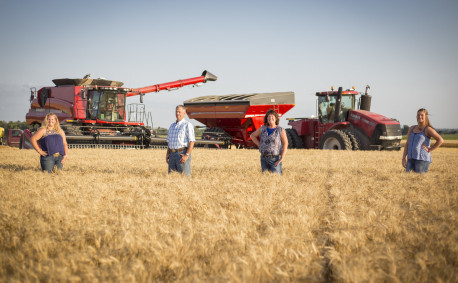How Farmers Prepare for Extreme Weather
As Kansans, we’re used to dealing with extreme weather. In fact, most of us were taught to head to the basement for shelter during a tornado before we knew our ABCs. There are protocols for us to follow when we’re home during a storm, but farmers face a more difficult situation: protecting their crops and livestock while staying safe themselves.
So how do they do it? We’re glad you asked.
How Farmers Deal with Heat Waves
If you’ve been stuck outside on a hot Kansas day, you know just how intense the heat is. Not only are high temperatures uncomfortable, but they can also be deadly for crops and livestock, so farmers need to take special care to keep their charges cool. Here are a few tools they use:
- Timed fans and sprinklers. Farmers set a specific temperature as a trigger for fans and sprinklers to turn on in the barn when the thermostat climbs high enough. Sprinklers are often located across the ceiling, so they reach animals in every stall. Fans help circulate air around the building and prevent a stale, stagnant environment.
- Barn design.Farmers consider location so they can make the building as efficient as possible. For example, barns built with large doors on the east and west sides take advantage of the direction of the wind, and benefit from natural ventilation.
- Monitoring and Technology. Tools like the U.S Meat Animal Research Center’s heat stress forecast and the Kansas Mesonet show projected temperatures and risk levels for certain areas on specific days and times. Farmers use this information to create their schedules. If livestock need to be transported, for example, they can arrange to do so on a cooler day. Soil probes and irrigation systems are also used to track the ground’s moisture level and adapt accordingly — farmers are alerted when soil gets too dry, then they use systems like pumps, tubes and sprinklers to water the land.
- Shade. No matter what they’re growing, farmers harness the power of shade to protect their plants. Shade cloths are placed above crops to shield them from the sun. Cloths come in a variety of forms and provide different levels of shadiness. Most materials still allow water to pass through, so farmers don’t need to remove them before watering their plants. Cover crops — plants grown for the benefit of the land, not to be sold — also provide shade for soil to help it retain moisture.
How Farmers Deal with Cold and Snow
Kansas freezes are neck-and-neck with heat waves for most uncomfortable conditions. And just like with scorching days, farmers have a few tricks up their sleeves for dealing with the challenge of whipping wind and freezing temperatures:
- Nutrients. As our bodies digest food, heat is produced. Farmers may take advantage of this phenomena and feed their livestock more during the winter months to encourage their bodies to create heat. This is especially important for expectant mother cows on the farm since calving season happens in winter — their bodies need the extra protein to feed themselves and their baby.
- Shelter. Something as simple as a windbreak can make all the difference when protecting livestock from the cold and snow. Having a facility large enough to house all animals when necessary is ideal, but even natural barriers can provide respite and help make everyone comfortable.
- Accessible water. Keeping livestock hydrated is important during any season, but this gets tricky if water freezes in the winter. To avoid an excess of ice and a shortage of water, farmers use heated troughs, which keep their contents above freezing for easy drinking.
How Farmers Deal with Tornadoes
While we’re heading downstairs at home, farmers need to make quick decisions. Of course, tornadoes often strike without much warning, so their priority is always keeping themselves and their families safe. But when times allows, here are a few ways farmers prepare for a tornado:
- Relocation. There are different schools of thought when it comes to where livestock should be during a tornado. Some farmers prefer to let the animals out of the barn, since damage to the building and flying debris pose huge threats to anything inside. Others believe it’s worth the risk to keep the livestock sheltered and choose to put everyone in the barn until the storm passes.
- Preparedness. Sometimes, destruction is inevitable. It’s important for farmers to have backup food, water and other supplies for tending to the animals in case their primary storage is harmed during the storm.
- Prevention. Since it’s impossible to move crops indoors during a tornado, the best way to ensure their survival is to have them as healthy as possible throughout the year. A well-maintained plant with strong roots is much more likely to survive a storm. Farmers make sure their crops are thriving year-round to put the odds in their favor.
The Kansas weather is known for throwing curveballs, but steadfast farmers use a variety of tools to protect their animals and crops from the harsh elements.





